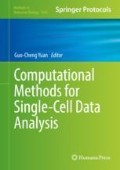Abstract
Single-cell RNA-seq (scRNA-seq) provides a comprehensive measurement of stochasticity in transcription, but the limitations of the technology have prevented its application to dissect variability in RNA processing events such as splicing. In this chapter, we review the challenges in splicing isoform quantification in scRNA-seq data and discuss BRIE (Bayesian regression for isoform estimation), a recently proposed Bayesian hierarchical model which resolves these problems by learning an informative prior distribution from sequence features. We illustrate the usage of BRIE with a case study on 130 mouse cells during gastrulation.
Access this chapter
Tax calculation will be finalised at checkout
Purchases are for personal use only
References
Grün D, van Oudenaarden A (2015) Design and analysis of single-cell sequencing experiments. Cell 163:799–810
Grün D, Lyubimova A, Kester L et al (2015) Single-cell messenger RNA sequencing reveals rare intestinal cell types. Nature 525:251–255
Gaublomme JT, Yosef N, Lee Y et al (2015) Single-cell genomics unveils critical regulators of Th17 cell pathogenicity. Cell 163:1400–1412
Papalexi E, Satija R (2018) Single-cell RNA sequencing to explore immune cell heterogeneity. Nat Rev Immunol 18:35
Scialdone A, Tanaka Y, Jawaid W et al (2016) Resolving early mesoderm diversification through single-cell expression profiling. Nature 535:289–293. https://doi.org/10.1038/nature18633
Wagner DE, Weinreb C, Collins ZM et al (2018) Single-cell mapping of gene expression landscapes and lineage in the zebrafish embryo. Science 80:eaar4362
Stubbington MJT, Lönnberg T, Proserpio V et al (2016) T cell fate and clonality inference from single-cell transcriptomes. Nat Methods 13:329
Lönnberg T, Svensson V, James KR et al (2017) Single-cell RNA-seq and computational analysis using temporal mixture modelling resolves Th1/Tfh fate bifurcation in malaria. Sci Immunol 2(9):eaal2192
Patel AP, Tirosh I, Trombetta JJ et al (2014) Single-cell RNA-seq highlights intratumoral heterogeneity in primary glioblastoma. Science 344:1396–1401
Tirosh I, Izar B, Prakadan SM et al (2016) Dissecting the multicellular exosystem of metastatic melanoma by single-cell RNA-seq. Science 352:189–196. https://doi.org/10.1126/science.aad0501.Dissecting
Wang ET, Sandberg R, Luo S et al (2008) Alternative isoform regulation in human tissue transcriptomes. Nature 456:470–476
Baralle FE, Giudice J (2017) Alternative splicing as a regulator of development and tissue identity. Nat Rev Mol Cell Biol 18:437
Dillman AA, Hauser DN, Gibbs JR et al (2013) mRNA expression, splicing and editing in the embryonic and adult mouse cerebral cortex. Nat Neurosci 16:499
Scotti MM, Swanson MS (2016) RNA mis-splicing in disease. Nat Rev Genet 17:19
Ziegenhain C, Vieth B, Parekh S et al (2017) Comparative analysis of single-cell RNA sequencing methods. Mol Cell 65:631–643
Faigenbloom L, Rubinstein ND, Kloog Y et al (2015) Regulation of alternative splicing at the single-cell level. Mol Syst Biol 11:845
Song Y, Botvinnik OB, Lovci MT et al (2017) Single-cell alternative splicing analysis with expedition reveals splicing dynamics during neuron differentiation. Mol Cell 67:148–161
La Manno G, Soldatov R, Hochgerner H et al (2018) RNA velocity of single cells. Nature 560.7719:494
Linker SM, Urban L, Clark S et al (2018) Combined single cell profiling of expression and DNA methylation reveals splicing regulation and heterogeneity. bioRxiv:328138
Huang Y, Sanguinetti G (2017) BRIE: transcriptome-wide splicing quantification in single cells. Genome Biol 18:123. https://doi.org/10.1101/098517
Huang Y, Sanguinetti G (2016) Statistical modeling of isoform splicing dynamics from RNA-seq time series data. Bioinformatics 32:2965–2972
Liu P, Sanalkumar R, Bresnick EH et al (2016) Integrative analysis with ChIP-seq advances the limits of transcript quantification from RNA-seq. Genome Res 26:1124–1133
Xiong HY, Alipanahi B, Lee LJ et al (2015) The human splicing code reveals new insights into the genetic determinants of disease. Science 1254806:347
Katz Y, Wang ET, Airoldi EM, Burge CB (2010) Analysis and design of RNA sequencing experiments for identifying isoform regulation. Nat Methods 7:1009–1015
Trapnell C, Williams BA, Pertea G et al (2010) Transcript assembly and quantification by RNA-Seq reveals unannotated transcripts and isoform switching during cell differentiation. Nat Biotechnol 28:511–515
Bray NL, Pimentel H, Melsted P, Pachter L (2016) Near-optimal probabilistic RNA-seq quantification. Nat Biotechnol 34:525
Kim D, Langmead B, Salzberg SL (2015) HISAT: a fast spliced aligner with low memory requirements. Nat Methods 12:357
Dobin A, Davis CA, Schlesinger F et al (2013) STAR: ultrafast universal RNA-seq aligner. Bioinformatics 29:15–21
Katz Y, Wang ET, Silterra J et al (2015) Quantitative visualization of alternative exon expression from RNA-seq data. Bioinformatics 31:2400–2402
Author information
Authors and Affiliations
Corresponding author
Editor information
Editors and Affiliations
Rights and permissions
Copyright information
© 2019 Springer Science+Business Media, LLC, part of Springer Nature
About this protocol
Cite this protocol
Huang, Y., Sanguinetti, G. (2019). Using BRIE to Detect and Analyze Splicing Isoforms in scRNA-Seq Data. In: Yuan, GC. (eds) Computational Methods for Single-Cell Data Analysis. Methods in Molecular Biology, vol 1935. Humana Press, New York, NY. https://doi.org/10.1007/978-1-4939-9057-3_12
Download citation
DOI: https://doi.org/10.1007/978-1-4939-9057-3_12
Published:
Publisher Name: Humana Press, New York, NY
Print ISBN: 978-1-4939-9056-6
Online ISBN: 978-1-4939-9057-3
eBook Packages: Springer Protocols

